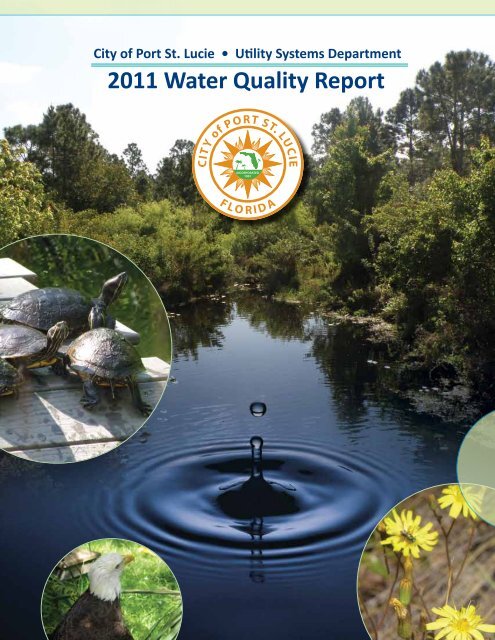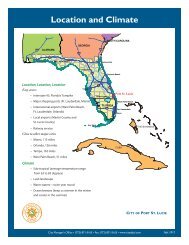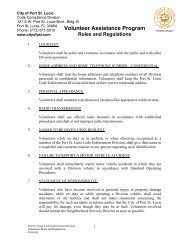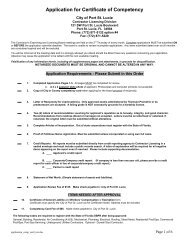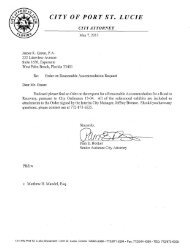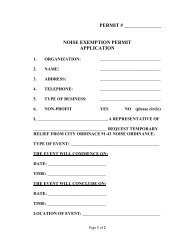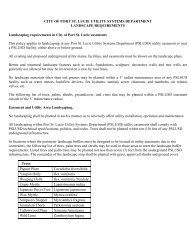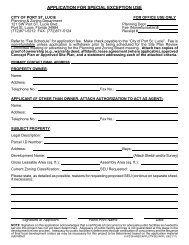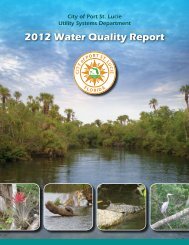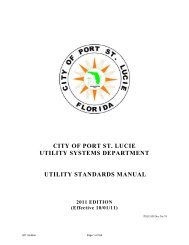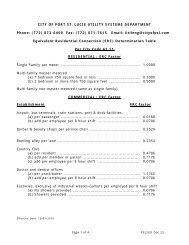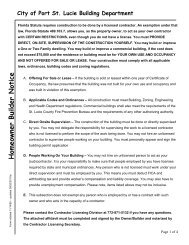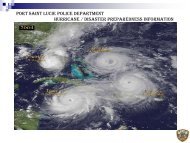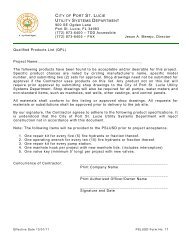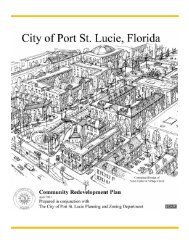2011 Water Quality Report | Utility Systems - City of Port St. Lucie
2011 Water Quality Report | Utility Systems - City of Port St. Lucie
2011 Water Quality Report | Utility Systems - City of Port St. Lucie
Create successful ePaper yourself
Turn your PDF publications into a flip-book with our unique Google optimized e-Paper software.
<strong>City</strong> <strong>of</strong> <strong>Port</strong> <strong>St</strong>. <strong>Lucie</strong> • <strong>Utility</strong> <strong>Systems</strong> Department<br />
<strong>2011</strong> <strong>Water</strong> <strong>Quality</strong> <strong>Report</strong>
A MESSAGE FROM THE DIRECTOR<br />
Clean, safe drinking water, that’s what customers want<br />
and that’s what the <strong>Port</strong> <strong>St</strong>. <strong>Lucie</strong> <strong>Utility</strong> <strong>Systems</strong> Department<br />
provides each and every day!<br />
In compliance with Federal legislation commonly<br />
called the 1996 Safe Drinking <strong>Water</strong> Act Amendments<br />
water utilities throughout the nation, including ours,<br />
are required to provide customers an annual written<br />
report detailing the quality <strong>of</strong> water they produce.<br />
This year’s report covers all <strong>of</strong> the water quality tests<br />
we performed between January and December <strong>2011</strong>.<br />
The Federal and <strong>St</strong>ate standards for water quality testing<br />
are set at very stringent levels. Allow me to say<br />
that the most important message in this entire report<br />
is the fact that the drinking water provided by the <strong>Port</strong><br />
<strong>St</strong>. <strong>Lucie</strong> <strong>Utility</strong> <strong>Systems</strong> Department continues to meet<br />
all Federal and <strong>St</strong>ate water quality standards!<br />
The Safe Drinking <strong>Water</strong> Act also requires us to include<br />
certain facts and data in the report that may contain<br />
abbreviations and terms that are unfamiliar to you.<br />
We cannot eliminate the use <strong>of</strong> those terms, but to<br />
help you better understand them, we have included a<br />
list <strong>of</strong> Important Definitions on page 6.<br />
The service slogan <strong>of</strong> our organization states that we<br />
are, “Connected to Our Community”, but our connection<br />
to the community goes far beyond having a<br />
catchy slogan. We connect to the community by providing<br />
the best possible water and wastewater service<br />
around-the-clock to our more than 65,000 water customers<br />
and more than 46,000 waste water customers.<br />
The <strong>Utility</strong> has streamlined our staffing levels and<br />
corresponding operating budgets, but I assure you the<br />
quality <strong>of</strong> service provided to our customers has not<br />
been sacrificed and it will not be.<br />
The current economy and ways to save money are near<br />
the top <strong>of</strong> everyone’s concerns. Conserving water use<br />
is a very good way to save money and help your budget.<br />
Please take a moment to read through and to<br />
practice the <strong>Water</strong> Conservation Tips that appear on<br />
page 4.<br />
If you have questions about this report or about any<br />
<strong>of</strong> our services, please feel free to contact us by calling<br />
our switchboard that is operated by highly trained <strong>Utility</strong><br />
employees who stand ready to assist you 24 hours<br />
a day. You can reach us at 772-873-6400 day or night.<br />
Jesus A. Merejo<br />
<strong>Utility</strong> <strong>Systems</strong> Director<br />
2
WHERE DOES OUR WATER COME FROM?<br />
Our water supply comes from two independent sources, the<br />
shallow aquifer and the deeper Floridan aquifer. Raw water<br />
from the shallow aquifer, which is about 100 feet deep, is<br />
treated by our 8.0 million gallon per day lime s<strong>of</strong>tening facility.<br />
This process is a combination <strong>of</strong> pH adjustments with<br />
lime, coagulation with a polymer, multi-media filtration, and<br />
disinfection with chloramines. The deeper Floridan aquifer,<br />
which is about 1,350 feet deep, is treated by our 11.15 million<br />
gallon per day and our 22.5 million gallon per day reverse<br />
osmosis facilities. Both finished waters are blended,<br />
pH adjusted, and fluoride is added.<br />
The sources <strong>of</strong> drinking water (both tap water and bottled<br />
water) includes rivers, lakes, streams, ponds, reservoirs,<br />
springs, and wells. As water travels over the surface <strong>of</strong> the<br />
land or through the ground, it dissolves<br />
naturally occurring minerals and, in<br />
some cases, radioactive material,<br />
and can pick up substances resulting<br />
from the presence <strong>of</strong><br />
animals or human activity.<br />
HOW SAFE IS OUR WATER?<br />
The <strong>City</strong> <strong>of</strong> <strong>Port</strong> <strong>St</strong>. <strong>Lucie</strong>’s <strong>Utility</strong> <strong>Systems</strong> Department routinely<br />
monitors for contaminants in your drinking water according<br />
to Federal and <strong>St</strong>ate laws, rules, and regulations.<br />
Except where indicated otherwise, this report is based on<br />
the results <strong>of</strong> our monitoring for the period <strong>of</strong> January 1 to<br />
December 31, <strong>2011</strong>. Data obtained before January 1, <strong>2011</strong>,<br />
and presented in this report are from the most recent testing<br />
done in accordance with the laws, rules, and regulations.<br />
In order to ensure that tap water is safe to drink, EPA prescribes<br />
regulations, which limit the amount <strong>of</strong> certain contaminants<br />
in water provided by public water systems. The<br />
Food and Drug Administration (FDA) regulations establish<br />
limits for contaminants in bottled water, which must provide<br />
the same protection for public health.<br />
Drinking water, including bottled water, may reasonably be<br />
expected to contain at least small amounts <strong>of</strong> some contaminants.<br />
The presence <strong>of</strong> contaminants does not necessarily indicate<br />
that the water poses a health risk. More information<br />
about contaminants and potential health effects can be obtained<br />
by calling the Environmental Protection Agency’s Safe<br />
Drinking <strong>Water</strong> Hotline at 1-800-426-4791.<br />
In addition, if present, elevated levels <strong>of</strong> lead can cause serious<br />
health problems, especially for pregnant women and<br />
younger children. Lead in drinking water is primarily from<br />
materials and components associated with service lines and<br />
home plumbing. The <strong>City</strong> <strong>of</strong> <strong>Port</strong> <strong>St</strong>. <strong>Lucie</strong> is responsible for<br />
providing high quality drinking water, but cannot control the<br />
variety <strong>of</strong> materials used in plumbing components. When<br />
your water has been sitting for several hours, you can minimize<br />
the potential for lead exposure by flushing your tap for<br />
30 seconds to 2 minutes before using water for drinking or<br />
cooking. If you are concerned about lead in your water, you<br />
may wish to have your water tested. Information on lead in<br />
drinking water, testing methods, and steps you can take to<br />
minimize exposure is available from the Safe Drinking <strong>Water</strong><br />
Hotline or at http:www.epa.gov/safewater/lead.<br />
Some people may be more vulnerable to contaminants in<br />
drinking water than the general population. Immuno-compromised<br />
persons such as persons with cancer undergoing<br />
chemotherapy, persons who have undergone organ transplants,<br />
people with HIV/AIDS or other immune system disorders,<br />
some elderly, and infants can be particularly at risk from<br />
infections. These people should seek advice about drinking<br />
water from their health care providers. EPA/CDC guidelines<br />
on appropriate means to lessen the risk <strong>of</strong> infection by Cryptosporidium<br />
and other microbiological contaminants are<br />
available from the Safe Drinking <strong>Water</strong> Hotline 1-800-426-<br />
4791.<br />
In <strong>2011</strong> the Department <strong>of</strong> Environmental Protection performed<br />
a Source <strong>Water</strong> Assessment on our system. The assessment<br />
was conducted to provide information about any<br />
potential sources <strong>of</strong> contamination in the vicinity <strong>of</strong> our wells.<br />
There are ten potential sources <strong>of</strong> contamination identified<br />
for this system with low to moderate susceptibility levels.<br />
It should be noted that the potential sources <strong>of</strong> contamination<br />
identified by this assessment project are just that: potential<br />
sources. All <strong>of</strong> <strong>Port</strong> <strong>St</strong>. <strong>Lucie</strong>’s facilities are regulated<br />
and operate under stringent construction and maintenance<br />
requirements designed to protect both human health and<br />
the environment. The purpose <strong>of</strong> conducting the source water<br />
assessments is to provide information that will lead to actions<br />
to reduce current risks or avoid future problems. The<br />
assessment results are available on the FDEP Source <strong>Water</strong><br />
Assessment and Protection Program website at www.dep.<br />
state.fl.us/swapp.<br />
3
CONTAMINANTS THAT MAY BE PRESENT IN<br />
THE SOURCE WATER INCLUDE:<br />
Microbiological contaminants, such as viruses and<br />
bacteria, which may come from sewage treatment<br />
plants, septic systems, agricultural livestock operations,<br />
and wildlife.<br />
Inorganic contaminants, such as salts and metals,<br />
which can be naturally-occurring or result from urban<br />
stormwater run<strong>of</strong>f, industrial or domestic wastewater<br />
discharges, oil and gas production, mining, or farming.<br />
Pesticides and herbicides, which may come from a variety<br />
<strong>of</strong> sources such as agriculture, urban stormwater<br />
run<strong>of</strong>f, and residential uses.<br />
Organic chemical contaminants, including synthetic<br />
and volatile organic chemicals, which are by-products<br />
<strong>of</strong> industrial processes and petroleum production, and<br />
can also come from gas stations, urban stormwater<br />
run<strong>of</strong>f, and septic systems.<br />
Radioactive contaminants, which<br />
can be naturally occurring or be<br />
the result <strong>of</strong> oil and gas production<br />
and mining activities.<br />
CROSS CONNECTION CONTROL:<br />
PROTECTING OUR WATER<br />
There are over 65,000 connections to our water distribution<br />
system. When connections are properly installed<br />
and maintained, the concerns are very minimal.<br />
However, unapproved and improper piping changes or<br />
connections can adversely affect not only the availability,<br />
but also the quality <strong>of</strong> the water. A cross connection<br />
may let polluted water or even chemicals mingle into<br />
the water supply system when not properly protected.<br />
This not only compromises the water quality but can<br />
also affect your health. So, what can you do? Do not<br />
make or allow improper connections at your homes.<br />
Even that unprotected garden hose lying in the puddle<br />
next to the driveway is a cross connection. The unprotected<br />
lawn sprinkler system after you have fertilized<br />
or sprayed is also a cross connection. Also, residents in<br />
neighborhoods utilizing reclaimed water for irrigation<br />
must take precautions to prevent cross connections.<br />
Reclaimed water is not suitable for potable use and<br />
must not be connected to household plumbing. When<br />
the cross connection is allowed to exist at your home<br />
it will affect you and your family first. If you’d like to<br />
learn more about helping to protect the quality <strong>of</strong> our<br />
water, call us at 772-873-6400 for further information<br />
about ways you can help.<br />
WATER CONSERVATION TIPS<br />
The power to conserve water rests with each one <strong>of</strong> us. Conserving<br />
water not only helps you save money, but it also helps<br />
preserve our water resources for the use <strong>of</strong> generations to come.<br />
Free and/or low cost water conservation tips include:<br />
Don’t let water run while brushing your teeth or shaving.<br />
When buying new appliances or plumbing fixtures, look for the<br />
“<strong>Water</strong>Sense” label. Products bearing that label meet the EPA’s<br />
criteria for water efficiency and performance.<br />
Repair or replace dripping and leaking faucets. A slow drip can<br />
waste 15-20 gallons <strong>of</strong> water per day.<br />
Make sure the rubber flapper in your toilet tank forms a tight<br />
seal that will keep water from leaking into the bowl. Replace toilets<br />
manufactured before 1994 with new water-efficient models.<br />
Remember to look for the “<strong>Water</strong>Sense” label.<br />
An automatic dishwasher uses about 15 gallons <strong>of</strong> water during<br />
every cycle, regardless <strong>of</strong> how many dishes and glasses are<br />
loaded into it. Get the most for your money and only run the<br />
dishwasher when it is fully loaded.<br />
If you have water level options on your washing machine, use<br />
the smallest amount <strong>of</strong> water necessary for a load. If your machine<br />
does not have water level options, get the most for your<br />
money by only washing full loads <strong>of</strong> laundry.<br />
Landscape with water-thrifty ornamental grasses, plants and<br />
trees. Group plants together according to similar water needs<br />
and mulch landscape beds to help retain moisture.<br />
Always follow the <strong>Water</strong> Use Restrictions imposed by South<br />
Florida <strong>Water</strong> Management District for landscape irrigation days<br />
and times.<br />
Additional water conservation tips and information about the<br />
importance <strong>of</strong> water conservation can be found at the following<br />
sites: www.city<strong>of</strong>psl.com, http://my.sfwmd.gov, or http://<br />
www.epa.gov/watersense.<br />
ENVIRONMENTAL PROTECTION: PREVENTING<br />
URBAN STORMWATER RUNOFF POLLUTION<br />
Use fertilizers sparingly and keep it <strong>of</strong>f driveways, sidewalks,<br />
and roads.<br />
Never dump anything down the storm drains.<br />
Compost your yard waste.<br />
Avoid pesticides; learn about Integrated Pest Management.<br />
(IPM)<br />
Pick up after your pet<br />
For more information <strong>of</strong> how you can minimize Urban <strong>St</strong>ormwater<br />
Run<strong>of</strong>f pollution, go to the following link. http://www.<br />
city<strong>of</strong>psl.com/npdes/combating-pollution.html<br />
4
TEST RESULTS TABLE<br />
For Prineville <strong>Water</strong> Treatment Plant<br />
Contaminant and<br />
Unit <strong>of</strong> Measurement<br />
INORGANIC CONTAMINANTS<br />
Dates <strong>of</strong><br />
Sampling<br />
(mo/yr)<br />
MCL<br />
Violation<br />
Y/ N<br />
Level<br />
Detected<br />
**<br />
Range<br />
<strong>of</strong> Results<br />
MCLG<br />
MCL<br />
Likely Source <strong>of</strong><br />
Contamination<br />
Fluoride (ppm)<br />
1/<strong>2011</strong><br />
N<br />
0.74<br />
N/A 4 4<br />
Erosion <strong>of</strong> natural deposits ;<br />
discharge from fertilizer and<br />
aluminum factories. <strong>Water</strong> additive<br />
which promotes strong teeth when<br />
at optimum levels between<br />
0.7 and 1.3 ppm<br />
Nitrate (ppm)<br />
1/<strong>2011</strong><br />
N<br />
0.14<br />
N/A 10 10<br />
Run<strong>of</strong>f from fertilizer use; leaching<br />
from septic tanks, sewage; erosion<br />
<strong>of</strong> natural deposits<br />
Sodium (ppm)<br />
1/<strong>2011</strong><br />
N<br />
86.2<br />
N/A N/A 160<br />
Salt water intrusion; leaching<br />
from soil<br />
RADIOLOGICAL CONTAMINANTS<br />
Radium 226 (pCi/L)<br />
4/2008<br />
N<br />
0.3<br />
N/A 0 5<br />
Erosion <strong>of</strong> natural deposits<br />
Lead and Copper Results<br />
These results are for the entire distribution system<br />
Contaminant and<br />
Unit <strong>of</strong> Measurement<br />
Dates <strong>of</strong><br />
Sampling<br />
(mo/yr)<br />
AL<br />
Violation<br />
Y/N<br />
90th<br />
Percentile<br />
Result<br />
# <strong>of</strong> Sites<br />
Exceeding<br />
the AL<br />
MCLG<br />
AL<br />
(action level)<br />
Likely Source <strong>of</strong><br />
Contamination<br />
Copper (tap water)<br />
(ppm)<br />
6/<strong>2011</strong><br />
N<br />
0.052<br />
0<br />
1.3<br />
1.3<br />
Corrosion <strong>of</strong> household plumbing<br />
systems; erosion <strong>of</strong> natural deposits;<br />
leaching from wood preservatives<br />
Lead (tap water)<br />
(ppb)<br />
6/<strong>2011</strong><br />
N<br />
3.1<br />
2<br />
0<br />
15<br />
Corrosion <strong>of</strong> household plumbing<br />
systems; erosion <strong>of</strong> natural deposits<br />
TTHMs and <strong>St</strong>age 1 Disinfectant/Disinfection By-Product (D/DBP) Contaminants<br />
These results are for the entire distribution system<br />
Contaminant and<br />
Unit <strong>of</strong> Measurement<br />
Chloramines (ppm)<br />
Dates <strong>of</strong><br />
Sampling<br />
(mo/yr)<br />
1-12/<strong>2011</strong><br />
MCL<br />
Violation<br />
Y/N<br />
N<br />
Level<br />
Detected<br />
**<br />
3.5<br />
Range<br />
<strong>of</strong> Results<br />
3.1 -<br />
3.6<br />
MCLG or<br />
MRDLG<br />
MRDLG<br />
= 4<br />
MCL or<br />
MRDL<br />
MRDL<br />
= 4<br />
Likely Source <strong>of</strong><br />
Contamination<br />
<strong>Water</strong> additive used to control microbes<br />
Haloacetic Acids<br />
(HAA5) (ppb)<br />
1,4,7,10<br />
<strong>2011</strong><br />
N<br />
14.4<br />
1.0 -<br />
38.0<br />
NA<br />
MCL<br />
= 60<br />
By-product <strong>of</strong> drinking water<br />
disinfection<br />
TTHM (Total trihalomethanes)<br />
(ppb)<br />
1,4,7,10<br />
<strong>2011</strong><br />
N<br />
26.4<br />
2.1 -<br />
57.0<br />
NA<br />
MCL<br />
= 80<br />
By-product <strong>of</strong> drinking water<br />
disinfection<br />
Contaminant and<br />
Unit <strong>of</strong> Measurement<br />
Asbestos (MFL)<br />
Dates <strong>of</strong><br />
Sampling<br />
(mo/yr)<br />
General Distribution Results<br />
These results are for the entire distribution system<br />
MCL<br />
Violation<br />
Y/ N<br />
Level<br />
Detected<br />
**<br />
Range<br />
<strong>of</strong> Results<br />
MCLG<br />
MCL<br />
10,11/<strong>2011</strong> N<br />
3.28 ND - 31.0 7 7<br />
Likely Source <strong>of</strong><br />
Contamination<br />
Decay <strong>of</strong> asbestos cement water<br />
mains; erosion <strong>of</strong> natural deposits<br />
** Results in the Level Detected column for radiological contaminants, inorganic contaminants, synthetic organic contaminants including pesticides and herbicides,<br />
and volatile organic contaminants are the highest average at any <strong>of</strong> the sampling points or the highest detected level at any sampling point, depending on the sampling<br />
frequency. For contaminants such as HAA5s that were sampled more than once in <strong>2011</strong>, the “level detected” will be the average <strong>of</strong> those results.<br />
5
TEST RESULTS TABLE<br />
For James E. Anderson <strong>Water</strong> Treatment Plant<br />
Contaminant and<br />
Unit <strong>of</strong> Measurement<br />
Dates <strong>of</strong><br />
Sampling<br />
(mo/yr)<br />
MCL<br />
Violation<br />
Y/N<br />
Level<br />
Detected<br />
**<br />
Range<br />
<strong>of</strong> Results<br />
MCLG<br />
MCL<br />
Likely Source <strong>of</strong><br />
Contamination<br />
INORGANIC CONTAMINANTS<br />
Fluoride (ppm)<br />
1/<strong>2011</strong><br />
N<br />
0.84<br />
N/A 4 4<br />
Erosion <strong>of</strong> natural deposits ;<br />
discharge from fertilizer and<br />
aluminum factories. <strong>Water</strong> additive<br />
which promotes strong teeth when<br />
at optimum levels between<br />
0.7 and 1.3 ppm<br />
Nitrate (ppm)<br />
1/<strong>2011</strong><br />
N<br />
0.14<br />
N/A 10 10<br />
Run<strong>of</strong>f from fertilizer use; leaching<br />
from septic tanks, sewage; erosion<br />
<strong>of</strong> natural deposits<br />
Sodium (ppm)<br />
1/<strong>2011</strong><br />
N<br />
85.4<br />
N/A N/A 160<br />
Salt water intrusion; leaching<br />
from soil<br />
IMPORTANT DEFINITIONS<br />
Maximum Contaminant Level or MCL: The highest level <strong>of</strong> a contaminant that is allowed in drinking water. MCLs are set as close to the MCLGs as<br />
feasible using the best available treatment technology.<br />
Maximum Contaminant Level Goal or MCLG: The level <strong>of</strong> a contaminant in drinking water below which there is no known or expected risk to health.<br />
MCLGs allow for a margin <strong>of</strong> safety.<br />
Action Level (AL): The concentration <strong>of</strong> a contaminant which, if exceeded, triggers treatment or other requirements that a water system must follow.<br />
Initial Distribution System Evaluation (IDSE): An important part <strong>of</strong> the <strong>St</strong>age 2 Disinfection Byproducts Rule (DBPR). The IDSE is a one-time study conducted<br />
by water systems to identify distribution system locations with high concentrations <strong>of</strong> trihalomethanes (THMs) and haloacetic acids (HAAs).<br />
<strong>Water</strong> systems will use results from the IDSE, in conjunction with their <strong>St</strong>age 1 DBPR compliance monitoring data, to select compliance monitoring<br />
locations for the <strong>St</strong>age 2 DBPR.<br />
Maximum residual disinfectant level or MRDL: The highest level <strong>of</strong> a disinfectant allowed in drinking water. There is convincing evidence that addition<br />
<strong>of</strong> disinfectant is necessary for control <strong>of</strong> microbial contaminants.<br />
Maximum residual disinfectant level goal or MRDLG: The level <strong>of</strong> drinking water disinfectant below which there is no known or expected risk to<br />
health. MRDLGs do not reflect the benefits <strong>of</strong> the use <strong>of</strong> disinfectants to control microbial contaminants.<br />
Million fibers per liter (MFL): measure <strong>of</strong> the presence <strong>of</strong> asbestos fibers that are longer than 10 micrometers.<br />
“ND” means not detected and indicates that the substance was not found by laboratory analysis.<br />
Parts per billion (ppb) or Micrograms per liter (ug/l): one part by weight <strong>of</strong> analyte to 1 billion parts by weight <strong>of</strong> the water sample.<br />
Parts per million (ppm) or Milligrams per liter (mg/l): one part by weight <strong>of</strong> analyte to 1 million parts by weight <strong>of</strong> the water sample.<br />
Picocurie per liter (pCi/l): measure <strong>of</strong> the radioactivity in water.<br />
6
INTERSTATE 95<br />
PORT ST LUCIE BLVD<br />
MIDPORT RD<br />
<strong>City</strong> <strong>of</strong> <strong>Port</strong> <strong>St</strong>. <strong>Lucie</strong><br />
Utilities System <strong>Water</strong> Distribution Map<br />
S.R. 70<br />
INTERSTATE 95<br />
2<br />
MIDWAY RD<br />
GLADES CUTOFF RD<br />
FLORIDA'S TURNPIKE<br />
SAEGER AVE<br />
EASY ST<br />
C-24 CANAL<br />
FLORIDA'S TURNPIKE<br />
GLADES CUTOFF ROAD<br />
ST LUCIE WEST BLVD<br />
PRIMA VISTA BLVD<br />
1<br />
INDIAN RIVER DR<br />
US HWY 1<br />
CROSSTOWN PKWY<br />
WALTON RD<br />
WALTON RD<br />
4<br />
CROSSTOWN PKWY<br />
JULIET AVE<br />
MIDPORT RD<br />
US HWY 1<br />
FLORIDA'S TURNPIKE<br />
TRADITION PKWY<br />
GATLIN BLVD<br />
C-24 CANAL<br />
GATLIN BLVD<br />
PORT ST LUCIE BLVD<br />
FLORIDA'S TURNPIKE<br />
PORT ST LUCIE BLVD<br />
5<br />
PORT ST LUCIE BLVD<br />
MARTIN/ST LUCIE COUNTY LINE<br />
6<br />
EAST-WEST 1<br />
INTERSTATE 95<br />
RANGE LINE ROAD<br />
COMMUNITY BLVD<br />
VILLAGE PKWY<br />
PORT ST LUCIE BLVD<br />
FLORIDA'S TURNPIKE<br />
3<br />
MARTIN/ST LUCIE COUNTY LINE<br />
VILLAGE PKWY<br />
SW PAAR DR<br />
BECKER RD<br />
BECKER RD<br />
C-23 CANAL<br />
MARTIN/ST LUCIE COUNTY LINE<br />
LEGEND<br />
<strong>Water</strong> Source<br />
1 - Prineville WTP<br />
2 - JEA WTP<br />
3 - Westport Repump<br />
4 - Midport Repump<br />
5 - Southport Repump<br />
6 - Rangeline Repump<br />
% JEA <strong>Water</strong><br />
0 - 20<br />
20 - 40<br />
40 - 60<br />
60 - 80<br />
80 - 100<br />
Existing Reclaimed <strong>Water</strong> Service Area<br />
7
<strong>City</strong> <strong>of</strong> <strong>Port</strong> <strong>St</strong>. <strong>Lucie</strong><br />
<strong>Utility</strong> <strong>Systems</strong> Department<br />
900 S.E. Ogden Ln<br />
<strong>Port</strong> <strong>St</strong>. <strong>Lucie</strong>, FL 34983<br />
PRESORTED<br />
STANDARD<br />
U.S. POSTAGE<br />
PAID<br />
COCOA, FL<br />
PERMIT #8678<br />
CITY OF PORT ST. LUCIE<br />
LEADERSHIP<br />
JoAnn M. Faiella<br />
Mayor<br />
Linda Bartz<br />
Vice Mayor District 1<br />
Michelle Lee Berger<br />
Councilwoman District 2<br />
Shannon M. Martin<br />
Councilwoman District 3<br />
Jack Kelly<br />
Councilman District 4<br />
Greg Oravec<br />
<strong>City</strong> Manager<br />
Jesus A. Merejo<br />
<strong>Utility</strong> <strong>Systems</strong> Director


